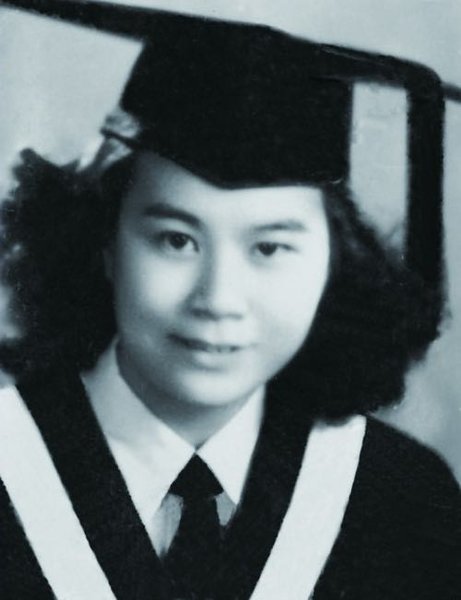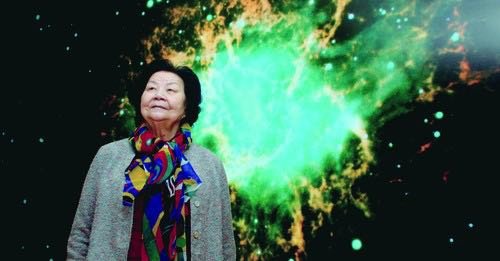
Ye Shuhua's graduation photo from the Department of Mathematics and Astronomy, under the School of Science, at National Sun Yat-sen University [China Women's News]
Ye Shuhua. a well-known astronomer and Chinese strategic scientist, has devoted herself to the astronomy in China for 68 years. Ye established the universal time system of China, and she is a pioneer of astronomical geodynamics. She is the first female observatory director in China. An asteroid is named after her, and she is honored as the "Mother of Beijing Time."
Ye, at the age of 93, still handles tasks at the Shanghai Astronomical Observatory (SHAO) on weekdays.
In the summer of 1951, Ye and her husband arrived in Shanghai. She was quickly recruited as the only female staff member of the Xujiahui (originally spelt Ziikawei) Observatory. At that time, the observatory was the only time service unit in China.
"During the international longitude joint measurements in 1926 and 1933, Xujiahui was selected as one of three global basis points. At that time, our facilities were very accurate," Ye said. "However, the equipment lacked precision after many years. In 1953, the State Council urged the Chinese Academy of Sciences (CAS) to strengthen time-related work. In 1957, the observatory used a large quartz clock to ensure the accuracy of time service."
In order to guarantee that the surveying and mapping work in Western China would receive correct time signals, the Chinese Government decided to set up the universal time system of China. Since the experienced staff was involved in the establishment of observatories in Beijing and Northwest China's Shaanxi Province at that time, Ye was designated to take charge of the universal time system of China.

Ye Shuhua makes observations with astronomical equipment in 1964. [China Women's News]
In order to find data processing methods suitable for the universal time system of China, Ye carried out tests for several months and finally found a method ensuring stable observation in a few observatories. After that, the universal time system of China was increasingly reinforced.
Since 1963, the accuracy of the universal time system has reached international levels. In 1965, the system passed state verification and it became the time benchmark of the country. Beijing Time was officially launched. The outcome showed that the accuracy of the universal time system of China exceeded the Soviet standard time system, ranking second in the world.
In 1973, Ye suggested developing very long baseline interferometry (VLBI) technology, which could not only be used in time but also applied in astrophysical research.
At her suggestion, China built a six-meter radio telescope in 1979, a 25-meter radio telescope in Shanghai in 1987 and a 25-meter radio telescope in Urumqi, Northwest China's Xinjiang Uygur Autonomous Region, in 1994.
At the beginning of China's lunar exploration project, Ye and the staff of the SHAO suggested using VLBI technology for orbit determination.
In early 2008, Ye fueled cooperation between the CAS and Shanghai to build a 65-meter radio telescope. In 2012, the telescope was completed in Shanghai, and it began playing an important role in China's deep-space exploration and astronomical research. In 2019, it won the Shanghai Science and Technology Progress Award and its overall performance ranked third in the world.
In 1994, Ye proposed the Asia-Pacific Space Geodynamics (APSG) project and she submitted it to the International Union of Geodesy and Geophysics in the next year. Ye won support from around the world for China's APSG project.
"It was the first time that China's astronomical circles initiated a large-scale international cooperation project that would be organized by us," Ye added.
"I have been working here for 68 years, but I still play my role even though I'm old. I still works at the office every day, often participating in some new projects," Ye said.
Ye has contributed greatly to astronomy research. In 1980, she was elected as a CAS academician; from 1981 to 1993, she served as director of the SHAO; in 1985, she was elected as a foreign member of the Royal Astronomical Society of Britain; from 1988 to 1994, she was elected for two terms as the vice president of the International Astronomical Union, and she is the first Chinese astronomer to take the post. In 1996 she was elected as the president of the cooperative APSG project.
Recipient and laureate of multiple honors and awards, Ye has won Major Achievement Awards from the CAS and the National Science Congress, the second prize in China's State Natural Science Award and the honorary title of Top Ten Outstanding Women.
On November 28, 1978, the Purple Mountain Observatory of CAS discovered No. 3241 asteroid which was named after Ye Shuhua in August 1994 with the approval of the International Astronomical Union.

Ye Shuhua attends a celebration of the International Year of Astronomy in 2009. [China Women's News]

